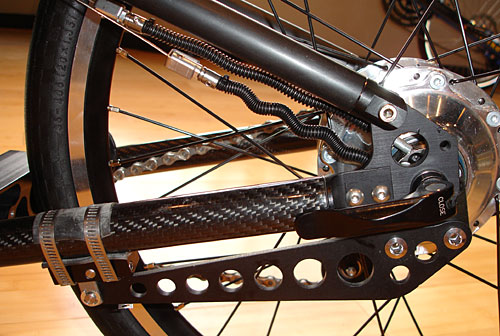Hi
I'm not sure if this is the right section to post in as there seems to be overlap between general/technical so i'm sorry if this is the wrong section.
I am planning to upgrade my bike to a cheap ebay hub motor to save myself some headaches however though the motor is stocked by local sellers torque arms are cheaper from china and may take longer, so can I ride temporarily on a steel or cromoly frame with a 1000W rear hub motor without any torque arms and will a wrench and some hose clamps make a difference (I have no means to make a torque plate of satisfactory quality) or should I not bother? My riding conditions are as follows:
My question is will these kinds of conditions cause dropout or motor failure without a heavy-duty torque plate setup or if I do something stupid accidentally like stall the motor and cause extreme torque to act on the dropouts? Would the dropouts be unsuitable for hub motors if I spread them (e.g. 130 -> 135) and in that case is it better to go with a front hub?
Also if I am getting a 350W front hub motor then do I need a torque arm for that if I'm riding with the conditions above, and what if I increase the voltage to 48 or 52V with 20-30A. It looks like the 250W/350W motors look the same so I wonder if it's just the controller that's different in these kits or would the 350W version be able to handle higher wattages better somehow?
p.s for some reason front hub bikes seem to be the most common type down here, at least from my observation, despite the lack of stealth...
thanks
I'm not sure if this is the right section to post in as there seems to be overlap between general/technical so i'm sorry if this is the wrong section.
I am planning to upgrade my bike to a cheap ebay hub motor to save myself some headaches however though the motor is stocked by local sellers torque arms are cheaper from china and may take longer, so can I ride temporarily on a steel or cromoly frame with a 1000W rear hub motor without any torque arms and will a wrench and some hose clamps make a difference (I have no means to make a torque plate of satisfactory quality) or should I not bother? My riding conditions are as follows:
- Hot Australian weather
- Primarily off-road
- A hilly area with most hills less than 500 metres long and max grade for most is about 1 in 10, though there are some very short 1 in 5 inclines
- looking to cruise at about 30kmh on level terrain with light pedaling
- Some short stretches of harsh unpaved terrain with dirt and rocks that I like to ride very roughly up and down
- Occasionally will haul heavy loads or burnouts
- 52V 30-40A
My question is will these kinds of conditions cause dropout or motor failure without a heavy-duty torque plate setup or if I do something stupid accidentally like stall the motor and cause extreme torque to act on the dropouts? Would the dropouts be unsuitable for hub motors if I spread them (e.g. 130 -> 135) and in that case is it better to go with a front hub?
Also if I am getting a 350W front hub motor then do I need a torque arm for that if I'm riding with the conditions above, and what if I increase the voltage to 48 or 52V with 20-30A. It looks like the 250W/350W motors look the same so I wonder if it's just the controller that's different in these kits or would the 350W version be able to handle higher wattages better somehow?
p.s for some reason front hub bikes seem to be the most common type down here, at least from my observation, despite the lack of stealth...
thanks


